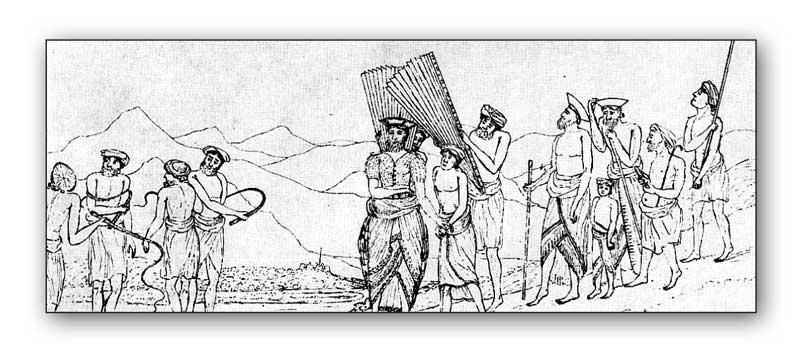23 Jul 2019 - {{hitsCtrl.values.hits}}

 In colonial societies, the colonisers frequently resorted to established traditional patterns of living, belief systems, and hierarchies based on caste, so as to perpetuate their domination. This usually led to a jettisoning of a minority from the rest of the country and the creation of a culturally colonised elite: the brown sahibs. Where the pre-capitalist phase of such countries did not facilitate the rise of a feudal landowning aristocracy, as was the case in Sri Lanka and Mughal India, disruptions to traditional patterns led to the emergence of new aristocracies and new caste and class structures which had their origins in the pre-capitalist phase.
In colonial societies, the colonisers frequently resorted to established traditional patterns of living, belief systems, and hierarchies based on caste, so as to perpetuate their domination. This usually led to a jettisoning of a minority from the rest of the country and the creation of a culturally colonised elite: the brown sahibs. Where the pre-capitalist phase of such countries did not facilitate the rise of a feudal landowning aristocracy, as was the case in Sri Lanka and Mughal India, disruptions to traditional patterns led to the emergence of new aristocracies and new caste and class structures which had their origins in the pre-capitalist phase.
The Portuguese administration found Sri Lanka’s land tenure system to be both flexible and sensitive. Within 18 years of taking over Kotte, Abeyasinghe writes, they were able “to transfer a large number of villagers” to their jurisdiction. The pace at which their lands were transferred accelerated following the accession of Jerónimo de Azevedo as Captain-General. Eventually, land came to fall under two categories: temple properties allocated to the Catholic church and made subject to royal pleasure, and properties the grantees of which paid a quit-rent and maintained lascarins or soldiers whenever they were needed for war.
Most of the gabadagam lands, used by the Sinhalese kings for their use and pleasure, had by 1615 been transferred to both foreigners and locals; naturally, the best lands went to the Portuguese, because of which a Portuguese landowning aristocracy (of sorts) emerged. At the same time, however, land transfers did not result in upheavals and rebellions as they would in the British era; in fact, in many instances the Portuguese followed the patterns of landholding their predecessors had instituted, to such an extent that it has been conjectured that “not one cultivator was displaced by the changes.” The only major addition to the system was the quit-rent, and even that was made applicable only to certain lands; many of the service lands were exempted from it, including those that belonged to cinnamon peelers.
Cinnamon, in fact, became the country’s main export crop, followed by coconut, arecanut, elephants, and less importantly, gemstones. Each of these had its own designated department, known as the mahabadda, and its own designated group of extractors and dealers; none of these, however, ever became as dear to the administration as cinnamon peeling. While it is far from the truth that trade flourished or that officials were able to balance the budget in the face of hostilities by aspiring regents (especially from Sitawaka), in the first few decades of their rule they allowed open trade before price slumps and depression compelled them to set up a rigid State monopoly. As for tax collection, the Portuguese continued the collection of dues that had been levied from locals at the time of the Sinhala kings.
In other words we see a trading class conduct transactions and deal with government officials even at the time of Portuguese colonialism. Dekum, one of the customary dues collected from officials, was also collected from tradesmen and craftsmen. There is every reason to believe that the Portuguese tampered very little with the caste lines that demarcated these tradesmen and craftsmen: dekum dues, for instance, were entered in the foral mostly against groups.
More trade oriented than the Portuguese, the Dutch enacted mercantile-styled policies which prevented this trading class from rising up any further. In effect, the new colonial powers prevented the formation of a bourgeoisie; a strictly supervised regime of monopolies and tariffs suppressed what little competition had existed before their imposition.
In fact it is during Dutch rule that we see regional trade change its momentum, from an atmosphere which brought benefits for all to one which exclusively entrenched one colonial power or the other. No doubt local tradesmen and craftsmen were denied proper opportunities to engage in open competition; what denied them those opportunities even further were the inflationary pressures, currency shortages, and agglomeration of debt (due to wars between Holland and its rival powers), all of which curtailed their activities. By the time of the British, the amount of money circulating in the economy had reduced, and though local traders were not wiped off, they were gradually coming into competition with foreign merchants.
Tradesmen, artisans, and craftsmen formed one part of what can be described as a local intermediate petty bourgeoisie; those put in charge of local administration, the headmen or Mudliyars, formed another part. Regarding the latter, the Portuguese, especially under Azevedo, faced a dilemma at the very beginning: should they obtain the loyalty of the local elites, or should they reward Portuguese military and administrative officials?
It was a question their policies never really resolved. In any case, the Mudliyars, who trace their origins to an earlier period in the island’s low country and the Maritime Provinces, converted to Christianity and were duly rewarded with grants of some of the finest lands in the country: Simao Correra received the village of Talampitiya, Samarakone received several lands in Matara, while Alagiyawanna Mukawati, who assisted with the completion of the tombo, received all his ancestral property in Hissella along with another village.
The Mudliyars had initially been military officers serving Sinhala kings. The Portuguese turned them into administrative officers and an intermediate class which the colonisers had to depend on and which, as Arno Meyer wrote, constantly “aspired upward.” On one hand, they readily converted to Catholicism; on the other, they married the daughters of Portuguese soldiers, further reinforcing the links between coloniser and the colonised.
These Mudliyars became more powerful in the Dutch era, since the they were more ignorant than their predecessors of native customs and languages; they were resorted to as interpreters, gaining for themselves a prestige their pre-colonial position had never endowed them with. Under Governor Falck, moreover, they were delegated the duties of local korales. No doubt this was taken as a precautionary measure: the Dutch wanted to reduce their military authority, and thus handed over more administrative powers to them.
Within the next few decades they began to display many of the hallmarks of a colonial elite: they were trusted over officials, they got the best lands, they set up residences in towns, and formed a culturally disconnected, urban absentee landlord population.
Historians and commentators have written extensively on what happened to this bourgeoisie and petty bourgeoisie in the British era, though most of them do not seem to acknowledge that their transformation in that period constituted a line of continuity from Portuguese and Dutch rule, especially with regard to the importance of the Mudliyars and their rise to the higher echelons of the administrative service.
Following the Colebrooke-Cameron reforms, the system of compulsory labour and land grants was abolished, and the Mudliyar class joined the bureaucracy as interpreters, tax collectors, and keepers of the peace. The opening up of the economy under severe colonial restrictions, the breakdown of the traditional order, and the takeover and sale of wastelands resulted in elements of the petty bourgeoisie graduating to the ranks of a new bourgeoisie. Initially starting out as rent collectors for fish, paddy, and road tolls, they were the first to benefit when the administration relaxed restrictions on arrack renting in the 1830s.
Fortunes made in the arrack and plantation industries in effect added a haute bourgeoisie to the ranks of the bourgeoisie, below the Mudliyar class (who gradually delved into plantation enterprises as well). Their status as elites, however, was qualified by colonial policies: they were debarred from participation in the export-import trade, were denied credit and banking facilities, and had little to no opportunities or motives for expansion beyond the plantation trade. The wealth they gained through mammoth profits in the arrack trade (in the British era there were no income, land, and inheritance taxes), however, put them above a secondary layer of entrepreneurs: the new petty bourgeoisie, more enterprising than and distinguished from the old who had carried on trade as a group of caste-centred communities.

The author can be reached on [email protected]
11 May 2024 3 hours ago
11 May 2024 5 hours ago
11 May 2024 8 hours ago
11 May 2024 8 hours ago
10 May 2024 9 hours ago